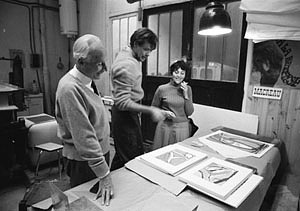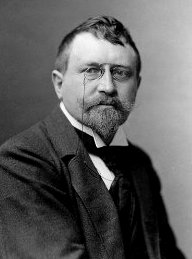Related Research Articles

Lyonel Charles Adrian Feininger was a German-American painter, and a leading exponent of Expressionism. He also worked as a caricaturist and comic strip artist. He was born and grew up in New York City. In 1887 he traveled to Europe and studied art in Hamburg, Berlin and Paris. He started his career as a cartoonist in 1894 and met with much success in this area. He also worked as a commercial caricaturist for 20 years. At the age of 36, he began to work as a fine artist. His work, characterized above all by prismatically broken, overlapping forms in translucent colors, with many references to architecture and the sea, made him of the most important artists of classical modernism. Furthermore he produced a large body of photographic works and created several piano compositions and fugues for organ.
Abstract expressionism in the United States emerged as a distinct art movement in the immediate aftermath of World War II and gained mainstream acceptance in the 1950s, a shift from the American social realism of the 1930s influenced by the Great Depression and Mexican muralists. The term was first applied to American art in 1946 by the art critic Robert Coates. Key figures in the New York School, which was the epicenter of this movement, included such artists as Arshile Gorky, Jackson Pollock, Franz Kline, Mark Rothko, Norman Lewis, Willem de Kooning, Adolph Gottlieb, Clyfford Still, Robert Motherwell and Theodoros Stamos among others.

Manfred Mohr is a German artist considered to be a pioneer in the field of digital art. He has lived and worked in New York since 1981.

Karl Christian Ludwig Hofer or Carl Hofer was a German expressionist painter. He was director of the Berlin Academy of Fine Arts.

Bramvan Velde was a Dutch painter known for an intensely colored and geometric semi-representational painting style related to Tachisme, and Lyrical Abstraction. He is often seen as member of the School of Paris but his work resides somewhere between expressionism and surrealism, and evolved in the 1960s into an expressive abstract art. His paintings from the 1950s are similar to the contemporary work of Matisse, Picasso and the abstract expressionist Adolph Gottlieb. He was championed by a number of French-speaking writers, including Samuel Beckett and the poet André du Bouchet.

Ralf Winkler, alias A. R. Penck, who also used the pseudonyms Mike Hammer, T. M., Mickey Spilane, Theodor Marx, "a. Y." or just "Y" was a German painter, printmaker, sculptor, and jazz drummer. A neo-expressionist, he became known for his visual style, reminiscent of the influence of primitive art.

The Neue Künstlervereinigung München (N.K.V.M.), was an Expressionism art group based in Munich. The registered association was formed in 1909 and prefigured Der Blaue Reiter, the first modernist secession which is regarded as a forerunner and pathfinder for Modern art in 20th-century Germany.
Heinrich Maria Davringhausen was a German painter associated with the New Objectivity.

Willi Baumeister was a German painter, scenic designer, art professor, and typographer. His work was part of the art competitions at the 1928 Summer Olympics and the 1932 Summer Olympics.
Rudolf Bredow, German post-expressionist painter, draughtsman and art teacher.

Leopold Gottlieb was a Polish-Jewish modernist painter and part of the School of Paris. His brother Maurycy Gottlieb, also a painter, died before Leopold was born.
Richard Paul Lohse was a Swiss painter and graphic artist and one of the main representatives of the concrete and constructive art movements.
Alexander Mohr (1892–1974) was a German Expressionist artist.
Max Ackermann was a German painter and graphic artist of abstract works and representational art.
Kurt Oscar Weber was a Swiss-American fine artist, primarily working in sculpture and painting. He worked in several genres of art including German Expressionism, Abstract Expressionism, Color fielding, and Figuration. He is known for his international solo and group exhibitions primarily presented in the US, France, Switzerland, Austria, and Germany. He maintained studios in Emeryville, California and in Uerikon near Lake Zurich for over 30 years.
François Willi Wendt was a French non-figurative painter of German origin belonging to the New École de Paris. After self-exile from Germany in 1937, he adopted France as his native country. In France he became "one of the best and most personal painters of his generation, an artist of great purity and strong culture. His self-exactness, lack of pretension and moral sense delayed the fame he deserved". In collective exhibitions he was associated with the most famous painters of the New École de Paris, particularly Roger Bissière, André Lanskoy, Serge Poliakoff, Pierre Soulages, and Nicolas de Staël. He is also associated with many better-known painters today.

Bernard Childs (1910–1985) was an artist who worked in Paris and New York. He was primarily a painter and printmaker, and pioneered the direct engraving of metal plates with power tools. As a kind of counterpoint to his many-layered work, which is often symbolic and a fusion of abstraction and figuration, in 1959 he also started painting portraits. Childs' formal interests were line and space, light and color, and the dialogue of contrasting elements.

Kumi Sugai was a Japanese painter and printmaker. Driven by an interest in avant-garde painting, Sugai moved to Paris in 1952 where he quickly attracted critical attention, participating in numerous exhibitions in Paris and abroad. First working in a style resembling informalism or lyrical abstraction, he became affiliated with the Nouvelle École de Paris. During the early 1960s, his artworks radically transformed when he developed a hard-edge abstract style influenced by his interest in automobiles and contemporary urban living. While he did not officially associate himself with any single artistic movement or group, he collaborated on multiple projects with his poet friends, Jean-Clarence Lambert and Makota Ōoka.

Hugo Curt Herrmann was a German Impressionist and Neo-Impressionist painter; associated with the Berlin Secession.
Hildegard Joos was an Austrian painter and is known as the "Grande Dame" of geometric abstraction and constructivism in Austria.
References
- ↑ "Adolf Fleischmann - Biography - Whitford Fine Art". Archived from the original on 9 February 2013. Retrieved 15 July 2011.
- ↑ "American Abstract Artists | Past Members". Archived from the original on 25 September 2010. Retrieved 12 October 2014.
- ↑ "Euromuse.net - the exhibition portal for Europe - euromuse.net - the exhibition portal for Europe - homepage".